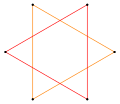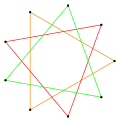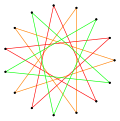Top Qs
Timeline
Chat
Perspective
Polygram (geometry)
Mathematical term in geometry From Wikipedia, the free encyclopedia
Remove ads
In geometry, a generalized polygon can be called a polygram, and named specifically by its number of sides. All polygons are polygrams, but they can also include disconnected sets of edges, called a compound polygon. For example, a regular pentagram, {5/2}, has 5 sides, and the regular hexagram, {6/2} or 2{3}, has 6 sides divided into two triangles.

A regular polygram {p/q} can either be in a set of regular star polygons (for gcd(p,q) = 1, q > 1) or in a set of regular polygon compounds (if gcd(p,q) > 1).[1]
Remove ads
Etymology
The polygram names combine a numeral prefix, such as penta-, with the Greek suffix -gram (in this case generating the word pentagram). The prefix is normally a Greek cardinal, but synonyms using other prefixes exist. The -gram suffix derives from γραμμῆς (grammos) meaning a line.[2]
Generalized regular polygons
A regular polygram, as a general regular polygon, is denoted by its Schläfli symbol {p/q}, where p and q are relatively prime (they share no factors) and q ≥ 2. For integers p and q, it can be considered as being constructed by connecting every qth point out of p points regularly spaced in a circular placement.[3][1]
 {5/2} |
 {7/2} |
 {7/3} |
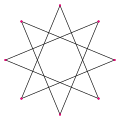 {8/3} |
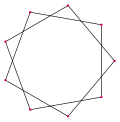 {9/2} |
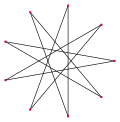 {9/4} |
 {10/3}... |
Remove ads
Regular compound polygons
In other cases where n and m have a common factor, a polygram is interpreted as a lower polygon, {n/k, m/k}, with k = gcd(n,m), and rotated copies are combined as a compound polygon. These figures are called regular compound polygons.
See also
References
Wikiwand - on
Seamless Wikipedia browsing. On steroids.
Remove ads

